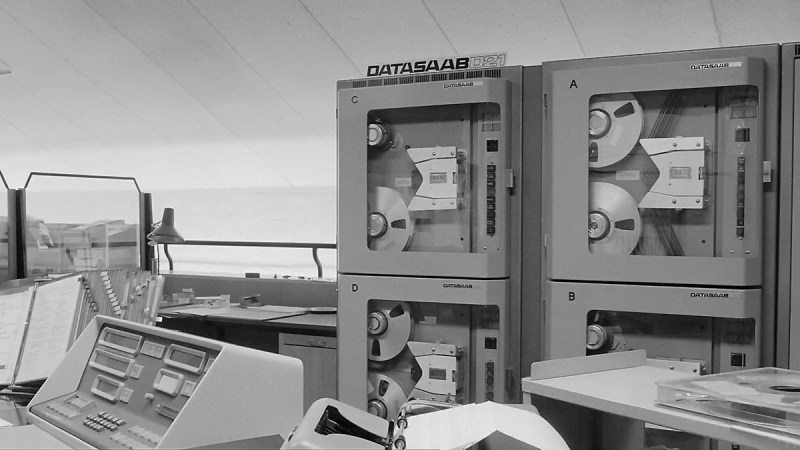Did you know that the land of flat-pack furniture and Saab automobiles played a serious role in the development of minicomputers, the forerunners of our home computers? If not, read on for a bit of history. You can also go ahead and watch the video below, which tells it all with a ton of dug up visuals.
Sweden’s early computer development was marked by significant milestones, beginning with the relay-based Binär Aritmetisk Relä-Kalkylator (BARK) in 1950, followed by the vacuum tube-based Binär Elektronisk SekvensKalkylator (BESK) in 1953. These projects were spearheaded by the Swedish Board for Computing Machinery (Matematikmaskinnämnden), established in 1948 to advance the nation’s computing capabilities.
In 1954, Saab ventured into computing by obtaining a license to replicate BESK, resulting in the creation of Saab’s räkneautomat (SARA). This initiative aimed to support complex calculations for the Saab 37 Viggen jet fighter. Building on this foundation, Saab’s computer division, later known as Datasaab, developed the D2 in 1960 – a transistorized prototype intended for aircraft navigation. The D2’s success led to the CK37 navigational computer, which was integrated into the Viggen aircraft in 1971.
Datasaab also expanded into the commercial sector with the D21 in 1962, producing approximately 30 units for various international clients. Subsequent models, including the D22, D220, D23, D5, D15, and D16, were developed to meet diverse computing needs. In 1971, Datasaab’s technologies merged with Standard Radio & Telefon AB (SRT) to form Stansaab AS, focusing on real-time data systems for commercial and aviation applications. This entity eventually evolved into Datasaab AB in 1978, which was later acquired by Ericsson in 1981, becoming part of Ericsson Information Systems.
Parallel to these developments, Åtvidabergs Industrier AB (later Facit) produced the FACIT EDB in 1957, based on BESK’s design. This marked Sweden’s first fully domestically produced computer, with improvements such as expanded magnetic-core memory and advanced magnetic tape storage. The FACIT EDB was utilized for various applications, including meteorological calculations and other scientific computations. For a short time, Saab even partnered with the American Unisys called Saab-Univac – a well-known name in computer history.
These pioneering efforts by Swedish organizations laid the groundwork for the country’s advancements in computing technology, influencing both military and commercial sectors. The video below has lots and lots more to unpack and goes into greater detail on collaborations and (missed) deals with great names in history.
















What happened to “by [Asianometry]”?
Usually HaD articles mention the name/nick/handle of the primary “source” they’re linking to…
Haven’t seen this video yet but I can recommend the [Asianometry] channel – a bit dry but the videos seem well researched & are quite interesting (eg. the ones about ASML, TSMC, Intel, some of their suppliers and the history and process of “making chips” in general).
Absolutely. I follow Asianometry and found it annoying that there was no direct credit in the article.
“Binär Aritmetisk Relä-Kalkylator” exactly how i imagine ikea would name their desktop computer if they made one.
Back in the day I did consultancy for FACIT and worked for Nokia Data. Ericsson bought Datasaab in 1981, making Ericsson Information Systems, and then Ericsson Information Systems was bough by Nokia in 1988, forming Nokia Data, which was acquired by ICL in 1991, which ended wholly owned by Fujitsu in 1998. (Long chain, I know, and I even left out the Danish IT-company Regnecentralen.)
I was in Linköping, where Nokia Data had part of their Swedish operations, when the first prototype of the SAAB developed Gripen fighter jet crashed, which could partly be seen from the Nokia Data offices. Luckily, the pilot suffered only minor injuries.
The article gets a few things backwards.
When the funding to Matematikmaskinnämnden was reduced, Facit (as it was called already then) hired all the staff who built BARK and BESK. Facit ADB was pretty much a copy of BESK. Later, in 1974 Datasaab acquired the computer business from Facit.
Also note that it was only the commercial business of Datasaab that was acquired by Ericsson, and not the military.
The abbreviations all have meanings in Swedish:
BARK – Bark (on a tree)
BESK – Bitter
SARA – A girl’s name
SANK – Marshy (land)
We her in Sweden love our witty abbreviations. One of my favorites is the old firewall of the Swedish army: FÄRIST – Cattlegrate.
One other is the standard entrenching tool of the army: KLAS – Kort, lätt attackspade (Short, light, combat spade)